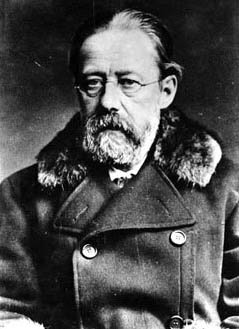Last night, I happily went to a nice event in my neighborhood, the first of the free Concerts from the Library of Congress that I have been able to attend this season. The Panocha Quartet, from the Czech Republic, presented three pieces from the repertories for which they have become known: Haydn and two Czech composers, Smetana and Dvořák. This is appropriate since we are in the "Year of Czech Music," a year with important anniversaries for Janáček (b. 1854) and Dvořák (d. 1904). From here they will go to New York, where they will be performing two Janáček quartets at Zankel Hall this Friday, and András Schiff will join them for Dvořák's Piano Quintet No. 2 in A Major, op. 81.
 The quartet took the stage of Coolidge Auditorium in matching black slacks, gray shirts, and maroon bowties. They created a restrained, delicate rendition of Haydn's String Quartet no. 2 in D Major (op. 33, no. 6), from the first group of pieces for this combination of instruments that the composer called quartets. The group's approach to Haydn took full advantage of their beautiful piano tone, which enhanced the contrasts of each movement, especially in the subdued solos for the violins in the Andante. By restrained, I do not mean to imply anything jejune in the Panocha's sound, because they had full volume available in the scherzo, a quick triple-meter romp that features nice outbursts from the cello (Jaroslav Kulhan) and a humorous longer-note ending for the viola (Miroslav Sehnoutka). The last movement, marked Allegretto, showed off the Panocha Quartet's remarkable virtuosity, especially the E-string purity and accuracy of the first violinist, who gave his name to the group, Jiří Panocha.
The quartet took the stage of Coolidge Auditorium in matching black slacks, gray shirts, and maroon bowties. They created a restrained, delicate rendition of Haydn's String Quartet no. 2 in D Major (op. 33, no. 6), from the first group of pieces for this combination of instruments that the composer called quartets. The group's approach to Haydn took full advantage of their beautiful piano tone, which enhanced the contrasts of each movement, especially in the subdued solos for the violins in the Andante. By restrained, I do not mean to imply anything jejune in the Panocha's sound, because they had full volume available in the scherzo, a quick triple-meter romp that features nice outbursts from the cello (Jaroslav Kulhan) and a humorous longer-note ending for the viola (Miroslav Sehnoutka). The last movement, marked Allegretto, showed off the Panocha Quartet's remarkable virtuosity, especially the E-string purity and accuracy of the first violinist, who gave his name to the group, Jiří Panocha.
Of course, the Panocha Quartet is known for its renditions of Czech composers, and they ended the first half with Smetana's
String Quartet no. 2 in D Minor, the briefer and lesser-known late quartet that followed the "From My Life" quartet in 1882 to 1883. (See David Hurwitz's
brief review of the first two Smetana quartets, performed by the Panocha Quartet.) The four movements of this quartet are unified by their openings, which are all dramatic
unisono melodies. The Panocha Quartet attacked the first movement
unisono crisply and warmed it into a slow, luscious homophony, a sound which alternated with very turbulent moments. The second movement is a duple folksy dance with a warm viola melody, balanced by the Panocha's blindingly, buzzingly fast third movement, with its fugal entries. Here, the Panocha Quartet showed its full hand in terms of breadth of sound, which had been perhaps intentionally restrained in the Haydn. The only sound that seemed lacking was a full bass in some large textures, from the tone of cellist Jaroslav Kulhan.
At intermission, people checked the score of the
Yankees-Red Sox game on their cell phones and generously shared the information with their neighbors. (I can't help but think that at least some of the empty seats in the auditorium had been reserved by baseball fans who decided to stay at home. Congratulations to Boston!) The program concluded with a substantial work, Dvořák's
String Quartet in E♭ Major, op. 51, nicknamed the "Slavonic." This was a piece the quartet knew quite well, having recorded the complete chamber works of this composer. The first movement has a somewhat ametrical, folksy feel to it, which was played to great effect. However, it was in the second movement that the Panocha Quartet truly excelled. It is a gorgeous piece based on the Dumka, a mournful type of Czech folk tune. The first violin's elegiac melody was answered by an impossibly muted viola, over the mandolin-like pizzicato cello. Folk music returns in the fourth movement,
Allegro assai, a rondo based on the Czech reel, the skočna, which again featured the extraordinarily fast and accurate playing of the Panocha Quartet.
Although I called out "Janáček" when the quartet took a second curtain call to acknowledge our applause, the second violinist announced, in heavily accented English, "waltz by Dvořák." They gave a tantalizing performance of one of that composer's
Two Waltzes for String Quartet. (I mentioned discovering these pieces when they were played by the Bartók Quartet at the National Gallery last March, as
reviewed on Ionarts.) It was a superlative musical
amuse-gueule to end an evening of listening.































































